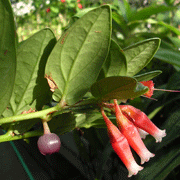James L. Luteyn and Paola Pedraza-Peñalosa
The New York Botanical Garden
|
|
Macleania was described by W. J. Hooker (1837) on the basis of one collection from Peru. He distinguished Macleania from the other genera of Andean Vaccinieae known to him by its 5-winged and truncate calyx limb (not conspicuously lobed), long corolla with comparatively very short stamens, connate staminal filaments, and anthers produced into a single tubule. In 1851, Klotzsch recognized ten species in Macleania. In his world-wide revision of generic limits in what he called the Vacciniaceae, J. D. Hooker (1876) characterized Macleania by having stamens shorter than the corolla, with granular thecae, and anther tubules fused but always rigid and narrowed. He (J. D. Hooker) further distinguished Macleania from Psammisia Klotzsch by the anther tubules being fused (not distinct as in Psammisia) and suggested that they were perhaps better treated as one genus, although he maintained them as distinct. Drude (1891), Hoerold (1909), Smith (1932), Sleumer (1941), Wilbur and Luteyn (1978), and Luteyn (1991c, 1997) have all emphasized the distinct nature of Macleania and its close relationship to Psammisia. |
Within Andean Vaccinieae, the genus Macleania, with 38 species recognized, has a distributional range spanning nearly that of the entire neotropical cordillera (southern Mexico to Peru), and is found from sea level to 3500 meters. Only two species are widespread, whereas the remaining are mostly narrow endemics. The center of diversity is western Colombia-Ecuador where 32 species are known to occur. The genus shows a wide range of morphological features, including many traditionally used as generic-limiting in the tribe, e.g., pedicels articulate or continuous with calyx, calyx and corolla terete or winged, stamens short to long in relation to the overall corolla length, filaments distinct or connate, tubules distinct or fused, etc. The only comprehensive taxonomic treatment of Macleania is that of Smith (1932), which described 22 of the approximately 38 currently recognized species. Since Smith's study, an additional 16 species of Macleania have been described (73% increase), although many of the species Smith (1932) recognized have been synonymized.
MACLEANIA Hook., Icon. pl. 2: pl. 109. 1837;
Smith, A. C., Contr. U.S. Natl. Herb. 28: 360-384. 1932; Yeo,
P., Baileya 15(2): 45-59. 1967; Luteyn, J. L., Fl. Ecuador
54: 120-164. 1996. Type: Macleania floridunda Hook.
Tyria Klotzsch, Linnaea 24: 21. 1851. Type: Tyria salapa (Benth.) Klotzsch (=Ceratostema salapa Benth.).
Straggly to compact, epiphytic or terrestrial
shrubs. Leaves alternate, coriaceous, entire; venation pinnate
or plinerved. Inflorescence axillary or terminal, racemose or subfasciculate
with few to many flowers, rarely flowers solitary. Flowers 5-merous,
without odor; aestivation valvate; calyx usually articulate
with the pedicel, but the joint sometimes obscure, rarely calyx continuous;
hypanthium short-cylindric or campanulate, often angled to conspicuously
winged, the wings sometimes protruding beyond the calyx limb as a spur;
limb erect and spreading (3-4-) 5-lobed; lobes triangular, subacute,
erect after anthesis; corolla carnose, elongate-urceolate to cylindric,
erete to angled, the lobes triangular, subacute, spreading, sometimes
spurred; stamens 10, equal, about one-quarter to nearly equalling
the corolla in overall length; filaments distinct or connate, dorsally
attached to the anthers near their bases, lacking spurs; anthers
stout, lacking disintegration tissue; thecae strongly granular,
usually curved inwards at the base; tubules rigid, broadly conical,
shorter to slightly longer than the thecae, 2 with these laterally connate
or distinct (rarely completely distinct) and dehiscing by two elongate
clefts, or 1 by total fushion and dehiscing by one elongate cleft;
pollen without viscin threads; ovary inferior; style filiform
and about as long as the corolla or slightly longer, basally surrounded
by an annular or cupuliform nectariferous disc. Fruit a spherical,
blue-black or translucent white berry; seeds often with a mucilaginous
sheath, the embryo sometimes green.
Key to Neotropical Species Back to Top
A a complete key is lacking but the genus is currently under revision. This version has been modified from Luteyn (1996b, 1997) and other unpublished notes.
